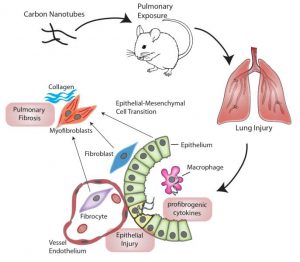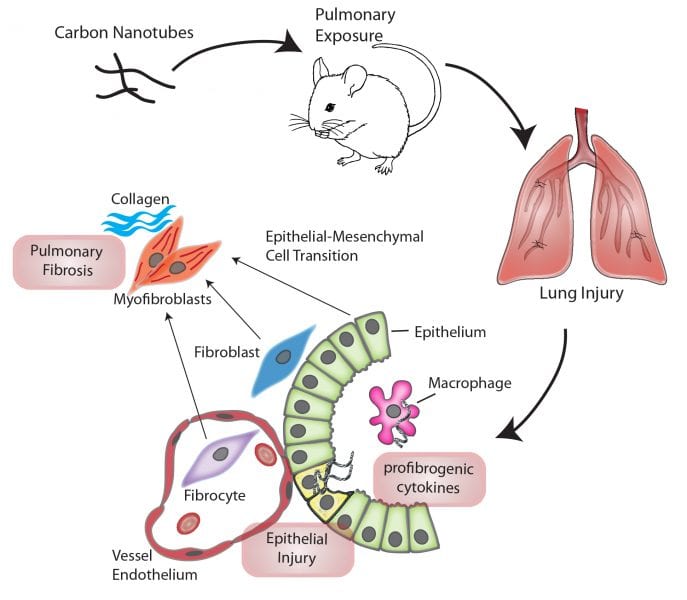
Pulmonary exposure to carbon nanotubes can result in direct interaction with cells in the lung and result in an increased myofibroblast population thereby enhancing fibrogenesis, the severity of which is determined by physicochemical characteristics of the nanotubes and genetic susceptibility.
Carbon nanotubes (CNTs) are man-made cylindrical sheets of graphene with a diameter that is a thousand times less than the width of a strand of hair. These materials are increasingly being used in polymer composites incorporated into consumer goods due to their enhanced thermal, electric, and mechanical strength properties. Fiber-like CNTs have properties reminiscent of asbestos and cause some of the same disease outcomes when they are inhaled into the lungs of laboratory mice. One of the most serious disease outcomes is scarring of the lung tissue, termed fibrosis. Engineering of these CNTs means they can be precisely designed and manufactured at the nanoscale with specific physical and chemical properties that determine their toxicity in the lung. CNTs can also be modified chemically after synthesis with organic or inorganic agents to modify or enhance these properties. Such materials present a new risk of occupational or consumer exposure that could impact human health.
A review article by Duke and Bonner in WIREs Nanomedicine and Nanobiotechnology, “Mechanisms of carbon nanotube-induced pulmonary fibrosis: a physicochemical characteristic perspective,” focuses on the physical and chemical properties of CNTs and how these subtle, but significant differences impact fibrosis in the lung. Drawing on scientific data from rodent exposure studies, they pare down the mechanistic data currently available for fibrotic development and severity. This article discusses both the physical and chemical properties known about CNTs and how these affect intracellular signaling pathways that lead to fibrosis. The likelihood to develop fibrosis also greatly depends on ones’ genetic makeup as well as CNT properties. This review also discusses a variety of genetic variabilities and how they are mechanistically regulating injury and repair to define a mechanism of CNT-induced pulmonary fibrosis. The review covers the current state of the literature on mechanisms of CNT-exposed pulmonary fibrosis in rodent models with a focus on physicochemical characteristics as principal drivers of the mechanisms leading to pulmonary fibrosis.
Kindly contributed by the Authors.

















